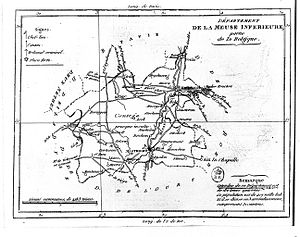- Meuse-Inférieure
-
Meuse-Inférieure (Lower Meuse; Dutch: Nedermaas or Beneden-Maas; German: Niedermaas) is the name of a département of the First French Empire in present Belgium, Netherlands and Germany. It is named after the river Meuse. Its capital was Maastricht.
The département was formed in 1795, when the Southern Netherlands and the left bank of the Rhine were annexed by France. Before the French occupation, the area was divided in several bigger and smaller states, among which:
- the County of Loon (Bishopric of Liège)
- Austrian Upper Guelders (Austria)
- Staats-Oppergelre (State Upper Guelders, United Provinces)
- the County of Horne (Bishopric of Liège)
- the abbacy of Thorn
- Maastricht and the Landen van Overmaas (part Austria, part United Provinces)
- part of the Duchy of Limburg
The département was subdivided into the following arrondissements and cantons:[1]
- Maastricht, cantons: Bilzen, Gulpen, Heerlen, Maasmechelen, Maastricht (2 cantons), Meerssen, Oirsbeek, Rolduc (now Dutch Kerkrade and German Herzogenrath) and Tongeren.
- Hasselt, cantons: Beringen, Borgloon, Hasselt, Herk-de-Stad, Peer and Sint-Truiden.
- Roermond, cantons: Achel, Bree, Maaseik, Niederkrüchten, Roermond, Venlo and Weert.
Its area was 3,925 km², and its population in 1806 was 232,662.[1]
After Napoleon was defeated in 1814, the département (excluding Niederkrüchten and Herzogenrath which were assigned to the Kingdom of Prussia and are presently located in North Rhine-Westphalia) became part of the United Kingdom of the Netherlands, as the Province of Limburg (with a part of the Roer département). Its territory corresponds largely with the present provinces Belgian and Dutch Limburg.
References
- ^ a b Almanach Impérial pour l'an MDCCCVI, p. 344, accessed in Gallica 27 May 2010 (French)
Territories annexed by the First French Empire (1804–1814) 44 départements (now parts of Luxembourg, Belgium, the Netherlands, Germany, Italy, Switzerland and Spain) created from annexed territoriesAlpes-Maritimes · Apennins · Arno · Bouches-de-l'Èbre / Bouches-de-l'Èbre-Montserrat · Bouches-de-l'Elbe · Bouches-de-l'Escaut · Bouches-de-l'Yssel · Bouches-de-la-Meuse · Bouches-du-Rhin · Bouches-du-Weser · Deux-Nèthes · Doire · Dyle · Ems-Occidental · Ems-Oriental · Ems-Supérieur · Escaut · Forêts · Frise · Gênes · Jemmape · Léman · Lippe · Lys · Marengo · Méditerranée · Meuse-Inférieure · Mont-Blanc · Montserrat · Mont-Terrible · Mont-Tonnerre · Montenotte · Ombrone · Ourthe · Pô · Rhin-et-Moselle · Roer · Rome · Sambre-et-Meuse · Sarre · Sègre / Sègre-Ter · Sésia · Simplon · Stura · Tanaro · Taro · Ter · Tibre · Trasimène · Yssel-Supérieur · Zuyderzée
Maastricht and related topics Culture GeneralFlag · Coat of arms · Judaism · Limburgish language (Maastrichtian variant) · Museums in Maastricht · Sjeng · The European Fine Art Fair (TEFAF)EducationJan van Eyck Academie · Maastricht School of Management · Maastricht University (incl. University College Maastricht) · Zuyd University of Applied Sciences (incl. Maastricht Academy of Dramatic Arts · Maastricht Academy of Fine Arts · Maastricht Academy of Music · Maastricht School of Hotel Management)HistoryFirst Siege (1579) · Capture of Maastricht (1632) · Second Siege (1673) · Third Siege (1748) · Département de Meuse-Inférieure (1795-1814) · Battle of Maastricht (1940)
Geography Geology & HydrologyRegion / Urban areaPolitics Local politicsInternational politicsSports Transportation A2 motorway · Maastricht Aachen Airport (shared with Aachen, Germany)· Maastricht railway station · Maastricht Randwyck railway stationCategories:- Former departments of France in Belgium
- Former departments of France in the Netherlands
- Former departments of France in Germany
- Heerlen
- Limburg (Netherlands)
Wikimedia Foundation. 2010.

